On the Bonnie Banks — Our Trip to UK
Jackson & Agnes He
December, 2005
Loch Lomond
Lady John Scott
By yon bonnie banks, and by yon bonnie braes,
Where the sun shines bright, on Loch Lomond.
Where me and my true love, were ever wont to gae,
On the bonnie bonnie banks of Loch Lomond.
Oh ye’ll tak’ the high road An’ I’ll tak’ the low road,
And I’ll be in Scotland afore ye.
For me and my true love will never meet again,
On the bonnie bonnie banks of Loch Lomond.
[More verses and music can be found, for example, at
NIH.] |
Way back when Jackson was in the more impressionable age and attending
a university with a romantic lake, he learned the song Loch Lomond (see box
to the right) from a friend and roommate. The lyrics his friend sang come from a
charming Chinese translation by a famed Prof. Deng Yingyi. The song made him
want to cry, and want to write one just like it for “their lake”. Alas, it was
not meant to be.
A few years later, after coming to the US, he learned that the expression
“I’ll take the low road” meant that “I’ll travel underground after my death”.
This tragic-heroic interpretation only made the song the more romantic.
He had since been to UK twice, but didn’t have the fortune to visit Loch
Lomond. Until this time, summer of 2005.
We were driving in the Scottish highland area, paying attention to the roads
that we would take and towns that we would pass by, but did not focus on which
lochs, glens or bens that we would visit. Then Loch Lomond just happened upon
us.
“Loch Lomond!” Jackson exclaimed when we saw the sign. “But is this The
Loch?” Agnes asked, knowing that the Chinese translation is but a phonetic
approximation. We stopped by a visitor center, and inquired with a nice
gentleman: “Is this the Loch Lomond that is in the song?” He said “yes”,
but Jackson was not convinced. He recited the first part, “By yon bonnie
banks, and by yon bonnie braes”, and Jackson was still not sure. Jackson
hummed the first phrase, and the man nodded, smiling.
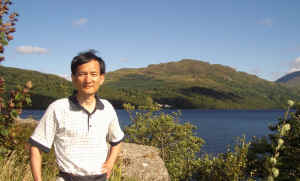 Loch Lomond is not unlike other lochs in Scotland. Long and narrow, it snuggles
between two mountains. Water is the same water everywhere, you can only tell the
differences by the mountains around it, and yet the differences are subtle. What
elevates Loch Lomond above all is the song, and the history behind the song. And
we felt connected to it instantly. [See history of
this, the more popular, version; and of
a more legendary version.]
Loch Lomond is not unlike other lochs in Scotland. Long and narrow, it snuggles
between two mountains. Water is the same water everywhere, you can only tell the
differences by the mountains around it, and yet the differences are subtle. What
elevates Loch Lomond above all is the song, and the history behind the song. And
we felt connected to it instantly. [See history of
this, the more popular, version; and of
a more legendary version.]
The whole trip was just like this, full of first time visits of familiar
places. We thought visiting the UK would be like meeting someone you have heard
and read so much about that when you finally meet that person you feel as if you
are enacting a mental script that you have written and rehearsed countless times
before. But we were only partially correct. Nothing fully prepares you for
walking into the pages of music sheets or history texts…
Summer 2005 will remain a memorable time for us. It was our 15th wedding
anniversary. It’s the year Agnes arrived at, according to Chinese wisdom, “the
age of enlightenment” and both of her parents turned “the age of historical
rarity”. To commemorate this occasion, we decided to take a 15-day vacation in
the UK, a place Agnes had dreamed of visiting ever since she started learning
the English language 30 years ago. Besides the four of us, Agnes’ parents also
joined us from Madrid. It was the first time the three generations of us met in
a place that is foreign to us all and spent some time together.
Even though it was fresh after the London tube bombings, we were determined
to make the trip. We reasoned that as long as US/UK troops are still in Iraq, a
threat of danger will always hang over us, whether we are there in the UK or
back here in the US. It turned out the timing was to our advantage. On the
surface, London appeared just as busy. But there were telltale signs that some
tourists stayed away. For example, we learned before the trip that the crown
jewels exhibit is generally very crowded, and one should attempt to go see it
first thing in the morning. When we went there close to lunch time, however,
there were no lines (sorry, queues) at either the ticket booth or at the
exhibit, and we could even go back to view the crown jewels again and again
after the moving belt delivered us to the end of the viewing platform!
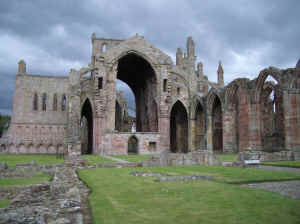 Melrose Abbey
Melrose Abbey
We spent 6 days in London, where we visited most of the popular tourist
destinations, such as the
River, the
Museum, the
Abbey, the
Cathedral, and
the Tower. Then we rented (or hired, as they say) a minivan and had even
more fun touring around areas of England and Scotland. In southern England we
spent two days visiting Oxford, Windsor, Stonehenge and Bath. In northern
England, we drove a motor boat on Windermere Lake. In Scottish Highlands, we
toured Loch Lomond, the Trossachs mountains, Eilean Donan Castle, the Culloden
Battlefield, Urquhart Castle, and Loch Ness. In Scottish Lowlands, we visited
the Edinburgh Castle, the Lothian region, the ruins of Dirleton and Tantallon
Castles, and the exquisitely beautiful Melrose Abbey. Our last stop on our way
back to London was the Sherwood Forest, where the legendary Robin Hood lived,
fought, and died.
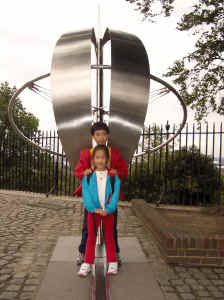 Prime Meridian, Greenwich
Prime Meridian, Greenwich
The trip brought to life much of we had read and learned about the UK and
taught us a lot that is new as well. For Luran and Yiran, the pretty Tower
Bridge turned out not to be the London Bridge they sing so well, and the London
Bridge is not there in London any more. Stonehenge means “hanging stones” and
Yiran drew a lovely picture of it from her memory and imagination in our hotel
room. You can be on the eastern and the western hemispheres at the same time if
you put one foot on each side of the Prime Meridian Line. The many castles are
perfect places for hide-and-seek and for pretend shootings and battles. And
London Eye is the world’s largest Ferris wheel.
When we saw
Nelson’s statute in Trafalgar square and elsewhere, and his name and
portraits in Maritime Museum; when we learned that
Queen Elizabeth I, the virgin queen, who some say sacrificed her personal
happiness for the prosperity of England; or when we heard that
Sir Walter Raleigh joked with his own executioner and gave the signal for
the axe to fall, our minds were jolted.
But when we saw Da Vinci’s mirrored handwriting in the Royal Library of
Windsor Castle, stood in the tiny room in Edinburgh Castle where
Mary Queen of Scots gave birth to
King James, the first king of the United Kingdom, walked the same walk Sir
Walter Raleigh paced everyday when he was imprisoned in the Tower of London, and
sat in the very seat that
Charles Dickens supposedly preferred (Ye Olde Cheshire Cheese on Fleet
Street, London, described as a tavern in
A Tale of Two Cities), the jolt was to the whole body.
We had thought that we understood the story of Robin Hood perfectly until we
visited Robin Hood Museum in the Sherwood Forest. There we learned that the
reason outlaws such as Robin Hood were called “wolf’s-head” is that if someone
hunted down an outlaw, the reward would be the same as if he hunted down a wolf.
We could continue recounting our rekindled interests and refreshing
discoveries. But given limited time, we will instead highlight the following.
The Rosetta Stone
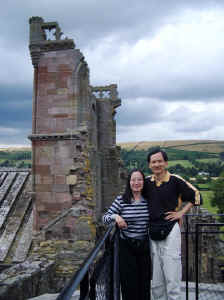 On top of Melrose Abbey
On top of Melrose Abbey
When you visit the Metropolitan Museum of Art, you can see that many ancient
Egyptian artifacts, such as sarcophaguses, bear very interesting markings,
including little birds, animals and other shapes. Are they a descriptive text,
or are they simply symbols of good fortune? If the former, is this a phonetic
language such as English, or a semantic-phonetic language such as Chinese? For a
long time, nobody knew.
What does it take to revive a dead language, and to unlock the secrets of
more than a thousand years of written history of an ancient civilization? You
would need to find a dictionary. But what if those ancient people didn’t leave
behind one? You’ll look for the next best thing, some text that is recorded in
two languages, one of which you can understand. The
Rosetta Stone is just such a thing.
Prior to the trip, Luran and we read a short and smart book called
The Riddle of the Rosetta Stone. From it, we learned that scholars first
figured out that two of the three sections on the Rosetta Stone seem to describe
the same text in two different languages, Greek and Demotic Egyptian. From that,
they inferred that the other section must also be the same content encoded in a
different language or a different script. With this revelation, the Rosetta
Stone became the dictionary that helped scholars to unlock the secrets of
Hieroglyphic Egyptian and thus the ancient Egyptian history.
The Rosetta Stone, now placed inconspicuously behind protective glass in
British Museum, stands in testimony to such a human conquest. And it is
precisely to that conquest, not Napoleon’s conquest of Egypt, nor British
victory over Napoleon which yielded Britain the Rosetta Stone, that we pay
homage today.
Westminster Abbey
Luran once commented that humans today are basically breathing the same body
of recycled air that early humans and other life forms did millions of years
ago. It was in the Westminster Abbey that we found resonance of his remark.
In the US we are generally used to the idea that churches are for the living
to worship, while the graveyard outside is for the dead to rest in peace. But
the Abbey is not only the place of worship for the current royal family but also
the burial place of many of the previous British monarchs. Among them are, for
example, King James, famed for King James Bible and “the King’s men” in
children’s rhyme Humpty-Dumpty. Queens
Mary I and Elizabeth I, half sisters, were buried together. Queen Mary tried
to bring England back to Roman Catholicism from Protestantism, killing hundreds
in the process, thus earning herself the nickname Bloody Mary. Elizabeth then
reverted England back to Protestantism, having just as many dissenters beheaded
(including her cousin Mary Queen of Scots), but over a reign almost ten times
longer.
For Agnes, the most emotionally stirring scene was the Poets’ Corner of
Westminster Abbey, where placed next to one another are the graves or memorials
(for those who were buried elsewhere) of
Chaucer,
Shakespeare,
Samuel Johnson, Charles Dickens,
Rudyard Kipling, Thomas
Hardy,
Milton,
Wordsworth,
Keats,
Shelley,
Robert Burns,
William Blake, T.S. Eliot
and
Jane Austen, the
Bronte sisters, Henry
James and many more… The last time Agnes saw these names side by side was on
the course reading lists of English literature at Beiwai (now Beijing Foreign
Studies University) 20 years ago. These are the very names that gave substance
and structure to “an English major” and that brought about both aspirations and
apprehensions in her. Their words had not only sensitized her to the rhythms and
routines of the English language but also gave her new ways of weighing the
world.
Tower of London
 At
Tower of London, a Yeoman Warder (a.k.a. beefeater, see picture) gave a most
wonderful tour. Beefeaters are guards of the Tower, but now apparently their
raison-d’etre became entertaining tourists. You may be able to read about all
the historical figures before or after your trip, but nothing compares hearing
the tales from the beefeater our guide. As part of the morning greeting ritual
he looked for an Australian in the crowd and said “Welcome home!” One story he
told was the execution of
Anne Boleyn, the second wife of Henry VIII. She was convicted of several
crimes, including treason. In the morning of the execution, our guide said, she
came to the Tower Green execution spot, and said “Good day!” to the executioner.
(“What a thing to say!” he exclaimed.) The executioner replied, “Good day, your
majesty my Queen!” He also told the story of Elizabeth insisting on entering the
Tower through the Traitor’s Gate, an entrance usually meant only for prisoners,
declaring: “If it was good enough for Elizabeth the Princess, it is good enough
for Elizabeth the Queen.”
At
Tower of London, a Yeoman Warder (a.k.a. beefeater, see picture) gave a most
wonderful tour. Beefeaters are guards of the Tower, but now apparently their
raison-d’etre became entertaining tourists. You may be able to read about all
the historical figures before or after your trip, but nothing compares hearing
the tales from the beefeater our guide. As part of the morning greeting ritual
he looked for an Australian in the crowd and said “Welcome home!” One story he
told was the execution of
Anne Boleyn, the second wife of Henry VIII. She was convicted of several
crimes, including treason. In the morning of the execution, our guide said, she
came to the Tower Green execution spot, and said “Good day!” to the executioner.
(“What a thing to say!” he exclaimed.) The executioner replied, “Good day, your
majesty my Queen!” He also told the story of Elizabeth insisting on entering the
Tower through the Traitor’s Gate, an entrance usually meant only for prisoners,
declaring: “If it was good enough for Elizabeth the Princess, it is good enough
for Elizabeth the Queen.”
The Tower has become synonymous with terror, treason, traitor, and torture.
The most gruesome account from our yeoman warder is the execution of Guy Fawkes,
who in November 1605 was caught for the
Gunpowder Plot, a scheme to blow up the monarch (King James) and the entire
British government. For that, Fawkes was sentenced to death and died a
horrendous death. He was hung, disemboweled and quartered. “The heart was the
last to be removed, and when the executioner held it in his hand, it- was-
stiiill beating,” said the yeoman warder, his voice thundering, his body leaning
toward us and his hand thrusting right towards Agnes’ chest.
Culloden Battlefield
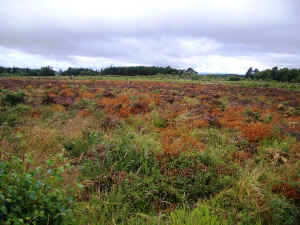 We
drove about the Scottish Highland area, where the vast beautiful yet desolate
mountain ranges, dotted with charming lochs, tell a heart-wrenching story. Three
hundred years ago, the locals, known as the highlanders, boosted by their
Catholic beliefs, fought against the English army to install
Bonnie Prince Charlie to the throne. After their fateful defeat, the
highland clams were decimated, with many scattered abroad. The area’s population
was never restored ever since.
We
drove about the Scottish Highland area, where the vast beautiful yet desolate
mountain ranges, dotted with charming lochs, tell a heart-wrenching story. Three
hundred years ago, the locals, known as the highlanders, boosted by their
Catholic beliefs, fought against the English army to install
Bonnie Prince Charlie to the throne. After their fateful defeat, the
highland clams were decimated, with many scattered abroad. The area’s population
was never restored ever since.
The second day of our highland tour, we visited Culloden Battlefield, just
off Inverness. This is the place where the last battle for Scotland, and
Catholicism, in the name of Bonnie Prince Charlie, was fought and bitterly lost.
Some 1,000 of the 5,000 Jacobites (supporters of Bonnie Price Charlie) were
killed by 9,000 Redcoats (the government’s army). There was no mercy for the
wounded soldiers; many were slaughtered where they had fallen, and those who had
managed to flee were hunted down and executed. The battle ground has been
preserved in a shape that approximates the way it was at the time of the battle.
Near the mass graves of the clansmen stone markers have been added, and have
already started to fade. The air was solemn, still and sad. Everywhere we
looked, it was wild grass and wild dark purple flowers that looked vibrant,
unaffected, and resilient — perhaps they are thistles, the Scottish national
emblem?
The Drive
“Are you really going to drive?” The friendly question was repeatedly put to
us before our trip. But we had made up our mind. Along with young children and
seniors, it actually seemed the simplest way to get around. Outside of London,
that is. Within London, we took taxis.
Driving in Britain was a lot of fun, it turned out. For the most part, we
were driving on the right side (of course this depends on the point of view -
what I meant is from the locals’ point of view). There were a couple of times
where we started the day driving on our right side, when the road was empty, and
then quickly realized our mistake when another car came towards us on the same
side of the road. The drivers in the other cars did not even honk at us, either
out of sympathy, magnanimity, or familiarity.
We loved the motorways, which are just like the interstates here in the US.
Once you get on, it felt right at home, and is just about impossible to make a
wrong turn. Local roads were much more challenging, especially the roundabouts.
Many a time when Yiran told us that she was feeling dizzy, we decided we must be
close to our hotel for the day. The worst experience was the “magic roundabout”
in Swindon (between Stonehenge and Windsor), where five little roundabouts
formed a circle. Surely it was a proud achievement for the locals, as it was a
headache for everybody else, figuratively and literally. To our delight,
roundabouts have not infected Scotland quite as badly.
Just as we were warned by the AAA book and numerous websites, in UK people
are very parsimonious about road signs. Even in London we realized that when you
turned out of a smaller road there would be in general no sign for the bigger
road. The generalized rule, seemingly applied all over the country, is that if
you want to know which road you are on, you really need to find out from one end
of the road or the other, but not in between. And for a couple of times we were
reminded by other friendly motorists that we were driving in the wrong
direction, against the locally well-established and obviously implied one-way
traffic rules, once in a gas (petrol) station, and the other time in the parking
lot (car park) of a hotel. But, no sweat. No one was in danger. We simply smile,
thank them, and wave goodbye.
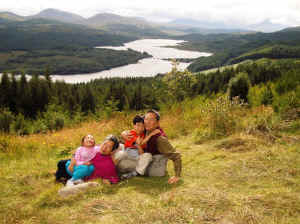 Kids with grandparents
Kids with grandparents
The most hair-raising driving experience was in Scotland, where without warning
we found ourselves on a road where the two directions share one single lane.
Although Jackson had read about these roads before the trip, he was misinformed,
thinking that they were only found with B roads — in UK non-local roads are
given a letter among M, A and B followed by a one to four digit number, M roads
being the best and B roads being the lowest grade. And while there were
“bubbles”, or short passing lanes of 20-30 yards long built along the road
periodically, the traffic was moving along rather aggressively, often at 50-60
mph! Even though our side turned out to be the straight side most of the time
while the other side had most of the “bubbles”, we never insisted on our right
of way.
Driving gave us more opportunity to explore the country, and to experience
its natural beauty. It also ultimately saved us some money. Even though the car
and the price of gas (petrol) were both much more expensive than in the US (even
more than the post-Katrina prices), we only needed one car (a mini-van) instead
of six train tickets, and we didn’t have to stay in expensive cities such as
Edinburgh, where due to the annual August international cultural festival no
rooms in a two-star hotel could be had for less than $200.
No shaking down any bridge, no frightening any mouse or queen, not even
picking destinations based on attractiveness to children, yet Luran and Yiran
enjoyed the trip thoroughly, to the point of shedding tears for having to leave
UK. And all the adults enjoyed it too.
Before our next journey, let us borrow another Scottish verse to bid you a
Happy New Year!
Should auld acquaintance be forgot,
And never brought to mind?
Should auld acquaintance be forgot,
And auld lang syne!
For auld lang syne, my dear,
For auld lang syne.
We'll tak a cup o' kindness yet,
For auld lang syne.
 Loch Lomond is not unlike other lochs in Scotland. Long and narrow, it snuggles
between two mountains. Water is the same water everywhere, you can only tell the
differences by the mountains around it, and yet the differences are subtle. What
elevates Loch Lomond above all is the song, and the history behind the song. And
we felt connected to it instantly. [See history of
this, the more popular, version; and of
a more legendary version.]
Loch Lomond is not unlike other lochs in Scotland. Long and narrow, it snuggles
between two mountains. Water is the same water everywhere, you can only tell the
differences by the mountains around it, and yet the differences are subtle. What
elevates Loch Lomond above all is the song, and the history behind the song. And
we felt connected to it instantly. [See history of
this, the more popular, version; and of
a more legendary version.] 




